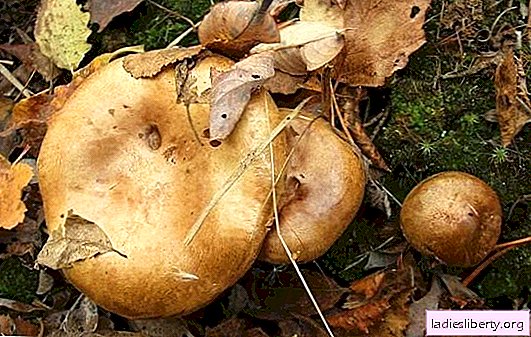
With the onset of autumn, a huge number of mushroom pickers rush into the forest. Despite the fact that every season a part of lovers of "forest meat" gets to the hospital with signs of intoxication, interest in "silent hunting" does not wane.
There are species of mushrooms that cause a lot of controversy. For example, pig mushrooms, the benefit of which is that they contain a number of useful substances, but at the same time they can harm health.
Appearance of sows and mushroom places
Pigs can be found in deciduous and coniferous forests, in meadows or near ponds. Often, these mushrooms grow under birch and oak trees, while in one instance they practically do not occur, they grow, as a rule, by "families".
The mushroom season begins in mid-July and ends in late October or early November. Autumn with frequent and heavy rains is considered especially fruitful, since mushrooms need not only warmth, but also a sufficient amount of moisture.
You can distinguish this variety of mushrooms by the following signs:
• pale green or grayish-brown color of hats;
• fleshy and thick hat with a diameter of 10 to 20 cm with inverted wavy edges;
• velvety or rough surface (in some cases - smooth);
• light yellow or brown flesh, quickly darkening at the cut;
• small legs up to 10 cm high and up to 5 cm in diameter, which can be either smooth or rough.
It is noteworthy that at an early age, mushroom caps are usually convex, and then they gradually align, after which they become funnel-shaped.
Composition and nutritional value of sows
Porcini mushrooms benefit the body due to its unique biochemical composition.
They are rich in the following substances:
• vitamins of groups A, B and C;
• iodine;
• fluorine;
• phosphorus;
• iron;
• potassium;
• sodium;
• magnesium;
• molybdenum;
• cobalt;
• calcium;
• phosphorus;
• zinc;
• chrome;
• various amino acids.
Indicators of nutritional value of this fungus are small. Carbohydrates and fats are found in pigs in a minimal amount, but at the same time they are able to enrich the human body with high-quality protein.
However, other types of "forest meat", less dubious in terms of safety, have similar properties.
Porcini mushrooms: what are their benefits for the body?
Due to the high content of beneficial microelements, porcini mushrooms have a positive effect on various organs and systems. Their use activates the following positive processes:
• normalization of lipid metabolism and cholesterol level;
• stimulation of vital processes in the body;
• blocking fat cells;
• strengthening the body's ability to resist the effects of microbes, viruses and infections;
• increasing the strength of bones and muscles;
• gentle cleansing of the body and activation of digestion;
• improvement of the heart, blood vessels and central nervous system;
• restoration of hormonal levels;
• elimination of headaches and insomnia;
• increase of working capacity and strengthening of the body's defenses.
In addition, sows have a diuretic and laxative effect, which helps to reduce weight, and due to the content of atrotomentin, their regular use minimizes the risk of cancer.
Mushroom pigs: harm and contraindications
According to the results of numerous studies conducted by Soviet scientists, in 1984, pigs were excluded from the list of conditionally edible mushrooms. From that time to the present moment they are considered poisonous and unfit for consumption.
This decision is due to the fact that toxic substances were found in the pigs that could not be destroyed even after prolonged heat treatment, and accumulating in the human body can cause various health problems. And also this mushroom has the ability to produce muscarine - a toxic substance that has a similar composition to the toxin contained in the fly agaric.
In addition, pigs, like many mushrooms, are able to absorb harmful substances from the soil and the environment. For example, even a harmless mushroom can become poisonous if it was ripped off near a highway or places of chemical waste.
Even with irregular use of sows, harmful substances can cause the following negative effects in the body:
• increased formation of antibodies and a change in blood composition;
• destruction of red blood cells and autoimmune reactions of the body;
• acute renal failure with possible fatal outcome.
However, despite warnings and reliable information that pig mushrooms can harm the body and even lead to death, many lovers of "forest meat" do not want to refuse to eat them and continue this unsafe game of "Russian roulette".
There are a number of cases where eating pigs is guaranteed to lead to negative consequences. These include:
• children's age up to 12 years;
• pancreatitis;
• diseases of the pancreas;
• pathology of the gastrointestinal tract.
Even a healthy person can feel serious discomfort as a result of excessive consumption of sows. There is a classic picture of poisoning, and in this condition urgent medical attention is required, otherwise it threatens death.
How to recognize poisoning by sows?
The danger of the sows is that the symptoms of intoxication may not appear immediately after the mushrooms have been eaten, but after a while. Procrastination is a serious danger, even death.
The signs by which poisoning can be recognized include:
• nausea and vomiting;
• diarrhea and abdominal pain;
• frequent heartbeat;
• profuse sweating and increased salivation;
• pallor or yellowing of the skin;
• signs of a malfunction in the respiratory system;
• manifestation of renal failure;
• delusions and hallucinations.
It is important to know that there is no antidote for exposure to toxic substances in sows. The longer a person puts off the ambulance call, the less chance he has of surviving.
How to reduce the risk of poisoning by sows
The best way to avoid poisoning the sows is to stop eating them. However, not every mushroom picker is ready to abandon this delicious dish.
To reduce the risk of health problems, you will need to follow these guidelines:
1. Collect mushrooms as far as possible from roads and human habitation, moving deeper into the forest.
2. Sort and clean the sows immediately after they have been collected.
3. After cleaning, put the mushrooms in water for 24 hours, after dissolving the salt and citric acid in it. During the day, change the liquid in which the sows are soaked, 2-3 times. This measure will help to remove harmful substances and salts of heavy metals from the product.
4. After soaking, thoroughly rinse the mushroom mass and cook in salt water for 5 minutes.
5. Replace the water, pour a few tablespoons of salt into it and boil the mushrooms for half an hour.
6. Repeat the fluid change procedure and cook the pigs again for at least 30 minutes.
7. Discard the mass in a colander and cool naturally. After such processing, you can start cooking any dish of mushrooms.
Compliance with these measures does not guarantee that the sows will become absolutely safe, but only will reduce the risk of poisoning. Therefore, it is important to be aware of the potential danger, and not to abuse this fragrant and tasty product.











